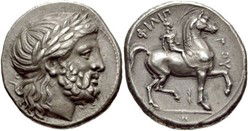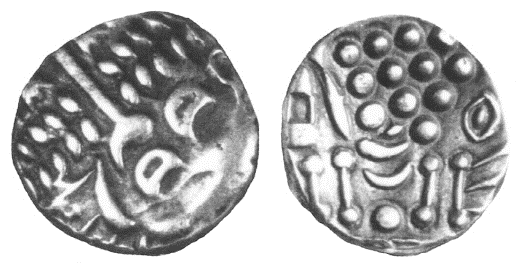The Celtic Durotriges Tribe and its coinage

[Image from Wikipedia 01.11.2021 By Numisantica - http://www.numisantica.com/, CC BY-SA 3.0 nl, https://commons.wikimedia.org/w/index.php?curid=25588164]
 (See also my page on Iron Age and Celtic Montacute). The Durotriges are likely to have been a confederation of smaller tribes with no single ruler, and what we know of their range is based on distribution of their coinage; Ptolemy’s 2nd century map of the British Isles (above) places them in South Somerset and Dorset, between the Belgae and Dumnonii, but their range probably extended to the north coast of Somerset (maps below from Wikipedia).
(See also my page on Iron Age and Celtic Montacute). The Durotriges are likely to have been a confederation of smaller tribes with no single ruler, and what we know of their range is based on distribution of their coinage; Ptolemy’s 2nd century map of the British Isles (above) places them in South Somerset and Dorset, between the Belgae and Dumnonii, but their range probably extended to the north coast of Somerset (maps below from Wikipedia).


Montacute lies within the area controlled by the Celtic Durotriges at the time of the Roman conquest (The Archaeology of Somerset, Ed. Aston and Burrow, 1982, p. 61) and Iron Age iron currency bars and coins from the Durotriges tribe have been found in Montacute parish on Ham Hill (Seaby 1949, https://www.jstor.org/stable/42661417); members of the Durotriges confederation occupied Ham Hill until the Romans arrived in around 45 AD, although most other Celtic tribes had stopped using hillforts by this time. Recent evidence suggests that at least some Durotrigan tribes may have been dominated by female lineages.
Celtic coins
Celtic coins are quite beautiful with later coins having unrecognisably stylised designs. The Celts started using coins around 150 BC and started making their own coins around 100 BC, replacing the use of iron bars as currency. Seaby's 1949 publication 'Coinage from Ham Hill in Taunton Museum' (https://www.jstor.org/stable/42661417) says that nearly 100 Celtic iron currency bars were found on Butcher's or Stroud's Hill in 1845, and he also records details of 10 Celtic staters from Ham Hill that were in the Taunton Museum in 1949.
Celtic coins were initially based on Greek coins (due to Macedonian demand for European Celtic mercenaries) and so initially often featured the head of Apollo on one side. This profile became more abstract with time.
Van Arsdell’s website https://vanarsdellcelticcoinageofbritain.com/ gives a good summary of Celtic coinage. Around 65 BC Durotrigan coins were similar to (and so tradeable with) coins of the Southern British tribes of the Belgae, Atrebates and Regnenses to the east. However by the time of the Gallic Wars (58 to 50 BC) Durotrigan coins followed the Armorican (Brittany) style of being primarily silver and billon, and not gold as used by other Celtic tribes, indicating that Armorica was their main trading partner. (Billon coins are made of an alloy, usually of silver although sometimes gold or mercury, with a majority base metal such as copper.) The Durotriges stopped using silver around 30 BC and started making bronze coins, initially struck but later produced by casting.
The evolution of Celtic currency from Macedonian coins is described on the NGC website

 The pictures above of a Macedonian coin from the British Museum (upper) and an early Celtic coin from the NGC website (lower) show the strong similarities between them. The Celtic coins were originally cast from Macedonian coins so the images are reversed. Over time the image and lettering degenerated, in this example the Greek lettering for Phillip (ΦΙΛΙΠΠΟΥ) which straddles the horse's head has, in the reversed Celtic image, been reduced to the zigzag design above and boxed circle in front of the horse.
The pictures above of a Macedonian coin from the British Museum (upper) and an early Celtic coin from the NGC website (lower) show the strong similarities between them. The Celtic coins were originally cast from Macedonian coins so the images are reversed. Over time the image and lettering degenerated, in this example the Greek lettering for Phillip (ΦΙΛΙΠΠΟΥ) which straddles the horse's head has, in the reversed Celtic image, been reduced to the zigzag design above and boxed circle in front of the horse.
Durotrigan Coins
Durotrigan coinage may indicates resistance to Romanization. Unlike eastern neighbours such as the Atrebates and Catuvellauni, Durotrigan coins contain no Latin inscriptions, Roman imagery, or references to individual rulers, contrasting sharply with other British Celtic tribes who used coinage for propaganda and alliance-building with Rome. Durotrigan coins found in South Somerset sites are typically small, worn, and made from debased metals, suggesting everyday use in local markets rather than prestige currency. The progression from gold and silver to bronze and tin alloys reflects either resource depletion or a deliberate shift toward utilitarian coinage for regular tribal transactions.

Image above, Durotriges gold stater, 18mm diameter "chute" type. 85-55 BC. Abstract head of Apollo (laurel leaves bisected by a line descending to a stylised ear) / disjointed horse (with "crab" pattern under horse). Image ref VA_1205 from Wildwinds website 01.11.2021.

Image above, Durotriges silver stater, typically approx 5g and 19mm diameter. This example 58-45 BC, abstract head of Apollo (laurel leaves bisected by a line descending to a stylised ear) / disjointed horse. Image from the Van Arsdell website 01.11.2021 https://vanarsdellcelticcoinageofbritain.com

Image above, Durotriges billon stater. This example 40-35 BC, 3.9g, 16.9mm. Head of Apollo (note stylised laurel leaves bisected by a line descending to a stylised ear) / disjointed horse (almost reduced to dots). Image ref VA_1252 from the Wildwinds website 01.11.2021. Billon is a gold/silver/copper alloy, there is a good description of the manufacturing process on Van Arsdell’s website

Image above, Durotriges silver quarter stater typically approx 1g and 11mm diameter. This example Duro Boat Bird Type, 58-43 BC. Three figures in a boat / Thunderbolt or lightning bolt surrounded by uncertain objects. Image ref VA_1242 from the Wildwinds website 01.11.2021.

Image above, Durotriges silver quarter stater, this example Starfish Type, 0.9g, 13mm, 35-30 BC. Image from Van Arsdell website https://vanarsdellcelticcoinageofbritain.com

Image above, Durotriges cast bronze, 10 – 45 AD. typically approx. 2.5g 16mm. Abstract head of Apollo (the dots replace stylised laurel leaves bisected by a line descending to a stylised ear) / pellets (disjointed horse degraded to dots!).

Disappointingly the Durotriges didn't use minims but here's a pic of one anyway! This is a reproduction coin (above), https://www.museumreproductions.co.uk/shop/viewitem.php?productid=798